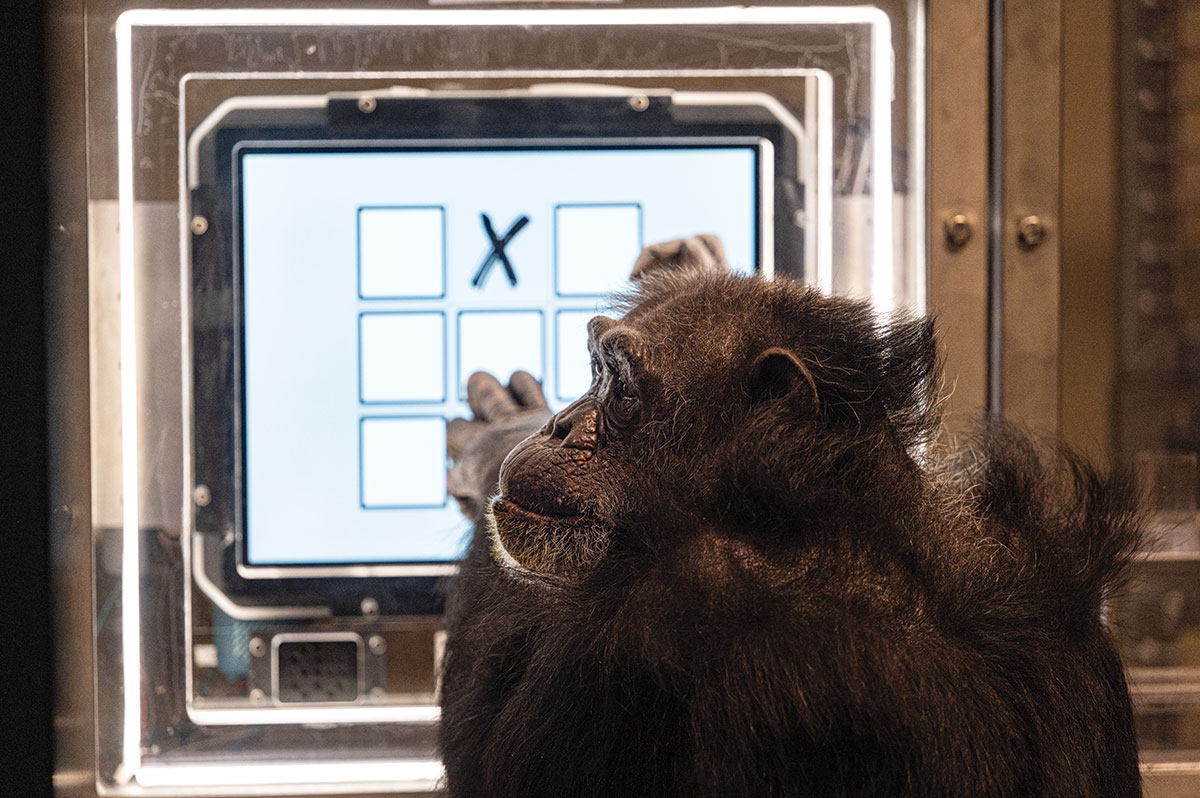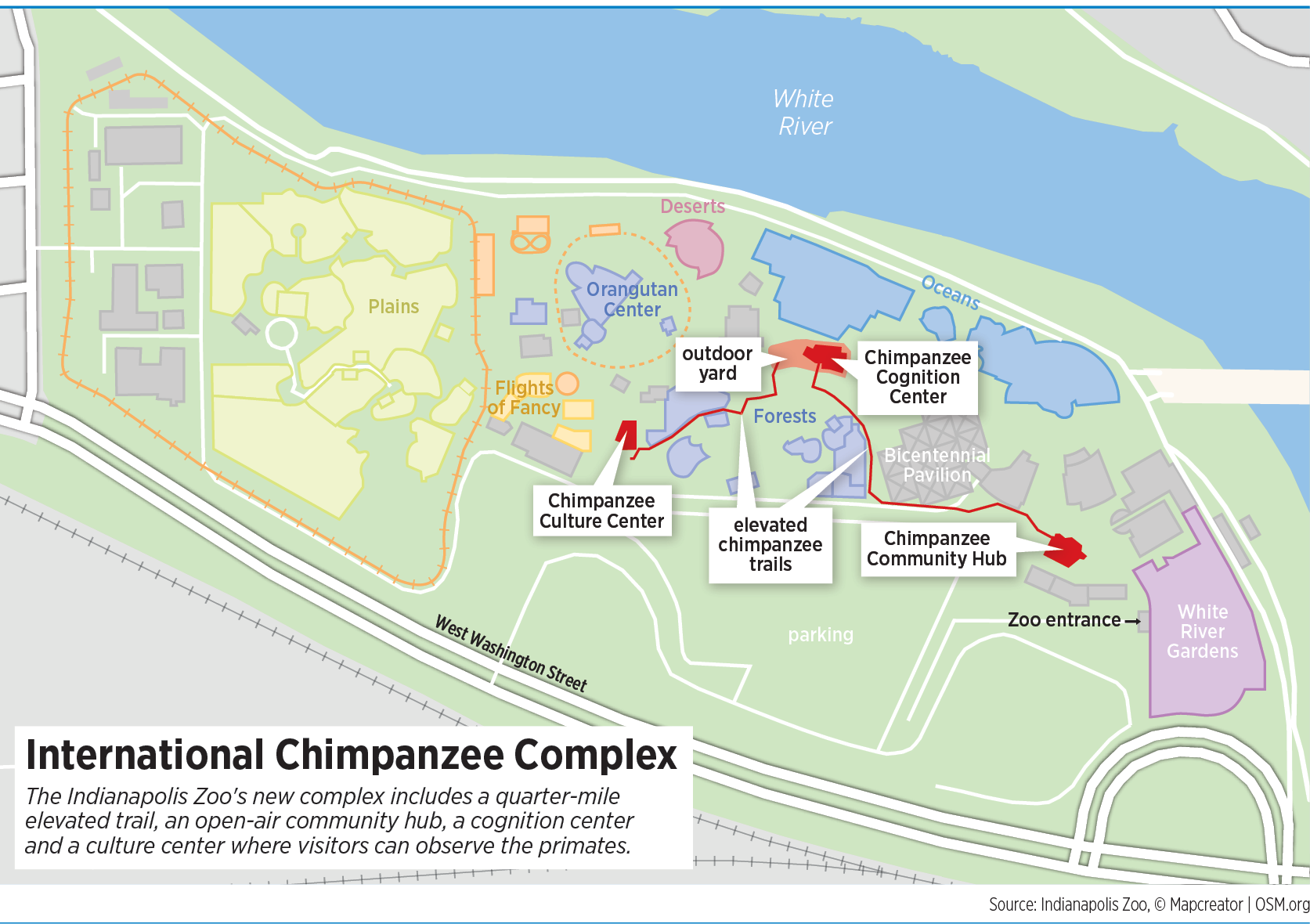Subscriber Benefit
As a subscriber you can listen to articles at work, in the car, or while you work out. Subscribe Now
After not featuring an exhibit of chimpanzees in more than 35 years, the Indianapolis Zoo plans to showcase the primates in a big way starting May 25.
The International Chimpanzee Complex will be home to 21 animals ranging in age from 12 to 58 years. The community is set to debut as the largest at any facility accredited by the Association of Zoos and Aquariums, and the $25 million habitat is designed to eventually accommodate as many as 30 chimps.
In contrast to fellow great apes such as gorillas, which live in small groups, and orangutans, which are solitary by nature, chimpanzees are known for forming communities in African forests.
“Chimps are like humans. We thrive in social settings,” said Chris Martin, the zoo’s director of research. “The most important thing for chimps is other chimps. It’s more important than any other factor in their life.”
It won’t be difficult for attendees to seek out the zoo’s new residents. Thanks to an elevated trail system that spans more than a quarter of a mile, it’s possible to see chimpanzees from the zoo’s parking lot.
Once you enter the zoo, 1200 W. Washington St., one of three gathering spaces in the International Chimpanzee Complex is front and center. A 36-foot tower for climbing dominates the open-air Community Hub, where radiant heaters and large fans can warm or cool the animals in extreme weather conditions.
The overhead trail system, a steel enclosure 14 feet above the ground, leads to Harlan/Shriver Families Cognition Center, where the work of chimpanzees on computer touchscreen stations will be studied, and the Deborah J. Simon Culture Center, which is designed for face-to-face interaction between humans (also classified as great apes) and chimps.

When zoo visitors watch chimpanzees move through the overhead trail, the chimps can look down to survey people as well as the zoo’s exhibits of tigers, bears and red pandas.
“We’ve had a few ‘people traffic jams’ watching chimpanzees watching kangaroos,” said Tim Littig, curator of primates, discussing the overhead trail’s preview sessions before the exhibit formally opens on Saturday of Memorial Day weekend.
Indianapolis Zoological Society CEO Rob Shumaker refers to the see-and-be-seen format as “equivalent perspectives” for attendees and chimpanzees.
No dedicated chimp habitat has debuted at an accredited U.S. zoo since Chicago’s Lincoln Park Zoo opened its chimpanzee space in 2004. “We have an obligation to do something different, something better and something that is innovative to really advance our profession,” Shumaker said.

Daniel Ashe, CEO of the Maryland-based Association of Zoos and Aquariums, said the Philadelphia Zoo has pioneered the use of mesh-enclosed trails for animals such as tigers and gorillas to travel above attendees in an attraction billed as Zoo360.
“Increasingly, our members are experts at holding and displaying animals in a way that the animals can be animals,” Ashe said. “If you see an elephant, it’s an elephant behaving like an elephant—not like a circus act. You see a gorilla or chimpanzee exhibiting natural behaviors because they have the space that encourages and allows them to exhibit their natural behaviors.”
Living and learning
The Culture Center of the International Chimpanzee Complex occupies part of the zoo once devoted to elephant and dog shows. Stadium seating of the past has been repurposed as a place where chimpanzees can hang out, and a multilevel climbing structure is part of the new building.
Martin, the zoo’s research director, said visitors can expect to see chases, negotiations for dominance and grooming among the animals.
Littig, who oversees the zoo’s primates, said the chimpanzees’ social interactions include males being loud and boisterous.
“I think that will be a big hit with a lot of our guests,” Littig said. “It can be really impressive when they do that, and it’s a normal part of everyday male expression of behavior.”
Inside the Cognition Center, which replaces a former lemur yard, chimpanzees will work at seven touchscreen interfaces designed by Martin.
The “Bananagon” stations feature games built on finding correct sequences and identifying images unlike others. Chimpanzees who play the games are rewarded with cereal pellets and peanuts that tumble into a tray.
“It’s all voluntary,” Martin said. “But we’ve found that they like working for their food. It’s a phenomenon called contrafreeloading, where animals like to work for their food. If you give them a choice between working for a reward versus just being handed the reward, most animals will want to work.”
Chimpanzees will decide when they visit the Culture Center, Cognition Center and Community Hub (which occupies part of the zoo’s former entry plaza).
“They get to make choices about where they go, when they go and who they go there with,” Littig said.

Building a community
Because no chimpanzees have been legally transported from Africa since an endangered species treaty was enacted in 1975, the community at the Indianapolis Zoo is made up of animals that previously lived in the Western Hemisphere.
Shumaker said the chimpanzees have been sourced from accredited and non-accredited zoos, private owners, the entertainment industry and a biomedical facility.
“We have some individual chimpanzees that have come from very difficult backgrounds,” Shumaker said. “They are absolutely thriving. They are fully immersed in a rich social environment. They interact wonderfully well with the other chimpanzees. They interact wonderfully well with our care staff and other people here at the zoo. I know they’re going to do the same with visitors.”
The zoo supports the Goualougo Triangle Ape Project in the Congo, where activists work to establish sustainable logging practices to improve the outlook for endangered chimpanzees and gorillas.
Martin said the International Chimpanzee Complex has the potential to motivate attendees to support conservation efforts.
“We want to get people enthused about chimpanzees in general by showing them what they’re capable of,” Martin said. “Maybe they will form an attachment if they have face-to-face interactions. We want our guests to care more about chimpanzees.”
Association of Zoos and Aquariums CEO Ashe said exhibits can foster a sense of empathy and responsibility.
“We are more and more living in cities and are disconnected from nature,” he said. “Experiences that people have in places like the Indianapolis Zoo make that connection back to nature and give people an appreciation, hopefully, for what they can do to protect it.”
Making history
The Indianapolis Zoo opened near the intersection of East 30th Street and Keystone Avenue in 1964. A chimpanzee reportedly jumped into the arms of Indiana Gov. Matthew Welsh during the zoo’s groundbreaking ceremony, and chimps named Doc and Sammy were known for their painting skills at the zoo in the 1960s and ’70s.
But no chimpanzees have lived at the zoo since the facility moved to White River State Park in 1988.
Ten years ago, the Simon Skjodt International Orangutan Center opened as a major primate attraction at the zoo. Earlier this year, votes by USA Today readers landed the orangutan center at No. 5 on a list of the best zoo exhibits in the United States.
Shumaker said the zoo reliably receives bumps in attendance when new exhibits open. In 2023, the zoo’s overall attendance figure was 1.2 million. Officials said they anticipate an increase of 200,000 visits in 2024, which is comparable to the spike that accompanied the orangutan center’s debut in 2014.
According to public records, the zoo collected admission fees of $6.8 million in 2013 and $9.1 million in the orangutan center’s opening year of 2014. Membership dues increased from $4.8 million to $6.7 million during the same period.
In 2022, the most recent year in which public records are available, the zoo collected $11.9 million in admission fees and $8.5 million in membership dues.
“We are a very different organization now than we were 10 years ago,” said Shumaker, who became president of the zoo in 2018. “We are a very different organization than we were five years ago. We are larger. We are more influential. We have a much deeper reach into field conservation work around the world.”
The Indianapolis Zoological Society, which operates the zoo, awarded the first Indianapolis Prize—a biennial award for leaders in the conservation of animal species—in 2006. Indianapolis Prize winners have received more than $1 million in unrestricted cash awards.
The 2024 edition of Zoobilation, a sold-out fundraiser for the zoo’s animal conservation mission, is scheduled for June 14 at the zoo.•
Clarification: In the headline for this story, the word “researched” was changed to “studied” to more accurately reflect inquiries into the animals’ behavior and cognition. The International Chimpanzee Complex is not an animal research facility. You can see other clarifications and corrections for IBJ stories here.
Please enable JavaScript to view this content.


Great! Now it needs an exhibit of gorillas, bats, wolves, hippos. And it really needs to expand waters building into a full-scale aquarium. These are all big draws. Come on, lly Endowment, step up and fund these!
And…bring back the popular Polar bears!
Always easy to spend others money, isn’t it?
Murray – the literal point of the endowment is to allow groups to spend their money on projects to make the city better….?
Wonderful keep enhancing, adding and growing!
Impressive. Excellent leadership.
Does every chimp have a name and will there is any new chimps born here in the future?
Yes on the names, Pat. And to increase the population from 21 to 30, the zoo plans to rely on new chimps born at the zoo.